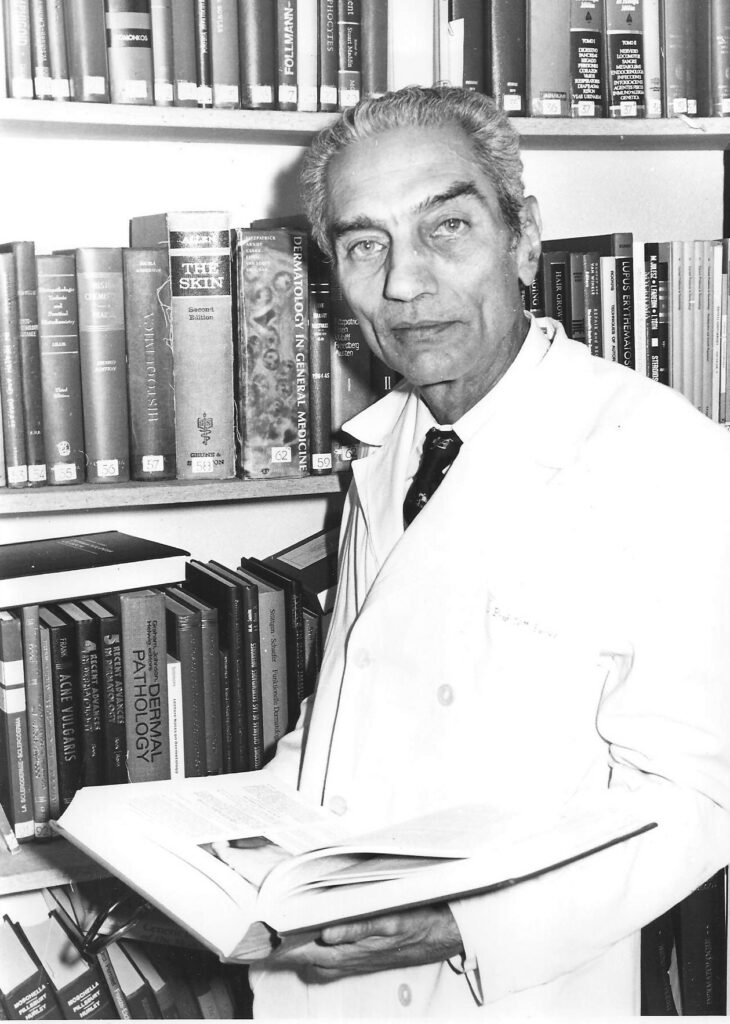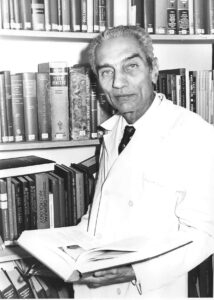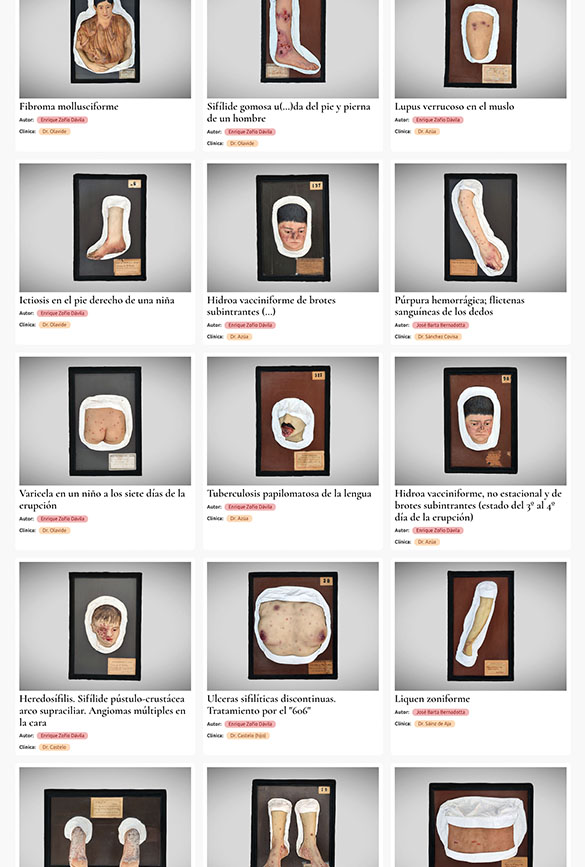Antonio García Pérez (1923-2002)
During the reign of Alfonso XII of Spain, Antonio García Pérez was born in Madrid in 1923, specifically on May 29th, on calle Álvarez de Castro 15. He was the fourth male child in a family of five brothers.His father, Ramón García Herbst, was an industrial engineer, and worked for a national railway company. His mother took care of the seven members of the family and also the maternal grandmother and her blind sister, who lived with the family. His paternal grandfather, José María García Ducazcal, was a professor at the School of Commerce in Valladolid and his maternal grandfather, Vicente Pérez González, was a magistrate and wrote some books under the pseudonym Vipegón. His father’s family had Central European roots. The paternal great-grandfather, Felipe Herbst, was born in Hayde (Bohemia, in what was once Austria-Hungary, now the Czech Republic). This left an important family mark since the whole family had a true devotion to music that they often heard in evening sessions on the radio. Opera was the best entertainment for the family and all the brothers maintained their enthusiasm for this hobby throughout their lives.
At the age of seven, he studied at Colegio de San José of the Marist brothers (1930). Three years later, in June 1933, he took the Baccalaureate entrance exam at the Instituto Cardenal Cisneros, obtaining honors. At this school he continued his baccalaureate during his first, second and third years. This last year coincided with the civil war, so, as he says, “I lived in the Madrid of bombings and hunger, what was called as the battle of Madrid, hearing the shootings and feeling the cannon shots and bombs of the air raids, with no little fear, but with much more hunger during my 13 to 16 years. I also lost three years of my studies, because, although I tried to continue studying on my own, I ultimately did not succeed.”
After the war, he returned to the Marists of Colegio San José, where he completed his fourth year of high school from May to October 1939, but since he could not continue taking intensive courses, his parents decided to transfer him to the Colegio Calasancio of the Piarist Fathers, where he completed his fifth year and sixth year of high school in a single course (1939-1940). Once he finished high school, he took the then-called ‘State Exam’ that was taken to obtain admission to the University and which he passed at the first attempt.
He began studying Medicine in October 1940. The first year of his medical degree was called ‘Preparatory’ and it was studied at the Central University, in the old mansion on calle San Bernardo that was the former Jesuit novitiate, where the Faculties of Law, Philosophy and Letters, and Sciences were based. The subjects were: ‘Chemistry for doctors’, ‘Physics for doctors’, ‘Biology’ and ‘Mathematics’. The first bench of the classroom was left free in honor of the fallen students and for the girls, who at that time were no more than three or four. The students were compulsorily affiliated with the SEU (Spanish University Union, affiliated to the Falange) since the card had to be presented to enroll. The second course, 1941-42, was taught in San Carlos, in the building built by Godoy at the beginning of the 19th century. He commented that “it was very common that upon reaching the fourth year, students began to ‘polarize’ towards some hospital service where they could ‘practice’, abandoning theoretical classes. This, which continues to happen in a certain way, has its justification in the ‘rush’ of seeing patients, of feeling like doctors – and its legal justification due to the lack of internships at the Faculty. But it is a double-edged sword: contact with theoretical and regulated training is required, which, whether one likes it or not, continues to be a fundamental aspect of the degree. I was no exception, and the summer of fourth year, or perhaps before, I started going with my brother to Manuel Arredondo’s Internal Medicine (digestive system) service at the Princesa Hospital. But the character of that summer was even more accentuated because during it I applied for a position as an interim internal student at the Provincial Hospital, a position that I obtained instead at San Juan de Dios. This indelibly marked my future.”
The Princesa Hospital was a hospital from the end of the century, with an enormous tradition in Madrid and located on the Glorieta de San Bernardo. “It was one of the most prestigious in Madrid. It had a central garden and cloister from which rooms on two floors radiated on both sides. On the right, men’s rooms, on the left, women’s rooms. The administration and management, the Emergency Service room and the operating rooms were located in the entrance patio. The outpatient examination rooms were located in an annex. Dr. Pedro Cifuentes, an urologist, was then the director. The interns began by being on call. When they arrived, they ate tortillas, steaks, and rice pudding that the nuns had prepared for them and stayed the night in the rooms. Usually three stayed on duty at night (surgeon, intern, and assistant).” At the end of the fourth year he was named interim internal student and, to his disappointment, assigned to the San Juan de Dios Hospital, that was a hospital of Dermatology and Venereology, which he had barely heard of. He was assigned to the Service of Dr. Felipe Sicilia.
During the last years of his career he alternated between the San Juan de Dios Hospital, the Princess Hospital, and the Faculty. He had great teachers, among whom he especially remembered Carlos Jiménez Díaz, a professor of Medicine who, he commented, “explained very well, perfectly representing his classes, with very good unaffected oratory and with very characteristic gestures.” In 1946 he took a competitive examination for internal students at the Provincial Charity. This examination was a program of about 80 subjects, of which 40 were preclinical subjects and the rest were clinical subjects. He was the second in his class, and was assigned to the San Juan de Dios Hospital.
He finished his degree in 1947 and remained as an internal student at the Provincial Charity, a position that was extended until the next examination. In 1948 he took the exams for internal doctor at San Juan de Dios, which he passed as the first in his class. The position was for four years and he chose the service of Orbaneja. In those years he also attended the Institute for Medical Research of Carlos Jiménez Díaz in the Pathological Anatomy service run by Manuel Morales, where he learned the histological technique and where he was in charge of the biopsies from the Orbaneja service to cut and dye. At that time, he began working in Carlos’ laboratory with Begoña Bravo Ramírez – whom he married in 1951. She was taking a course and later worked in Dr. Arjona’s Laboratory, at the Jiménez Díaz Clinic and also in San Juan de Dios Hospital.
He entered the Academy of Dermatology in 1947, having just finished his degree, which almost coincided with a renewal of the Board of Directors, which Gay presided over and which he entered that same year as Recording Secretary.
In 1950 he took a competitive examination for the Anti-venereal Fight, and asked for the position of ‘Deputy Director’ of the Trillo Leprological Sanatorium that was newly installed there since Fontilles (1943). He had to combine it with the position as an internal doctor at San Juan de Dios, so he went to Trillo from Friday to Sunday. The result of that work in Trillo was the Doctoral Thesis Leprosy reactions, of which, curiously, no copy survives and which he presented in Madrid in June 1952. He later produced the book Leprosy with Orbaneja (1953, Ed. Paz Montalvo). He obtained the March Scholarship with which he carried out a study of the nervous and trophic lesions of leprosy.
In 1954 his contract at the San Juan de Dios Hospital was ending, so he decided to take a competitive examination for director of a leprosarium in the Protectorate of Morocco that the state was going to set up in Larache. He obtained the position and went to Larache with his wife and two young daughters (2 years and 2 months respectively). The leprosarium had around twenty or thirty patients. Antonio aspired to install a laboratory in the office he had and had the help of a Muslim nurse and a male nurse as well as an ‘assistant’. He also had a dermatology consultation in which he saw numerous and important pathologies. He only stayed in Larache for a few months. Life there was very hard and the state did not provide him with the material for the leprosarium to function. Also the end of the Protectorate was imminent, so he returned to Madrid and continued as deputy director of Trillo and attending patients as an Insurance specialist in Guadalajara.
In 1958 he took a competitive examination for the Public Health Insurance organization called Seguro de Enfermedad and was enrolled at the National School as a specialist. In 1960 he carried out new competitive examinations, this time to obtain the position of Chief Clinical Officer of San Juan de Dios, and in January 1962 the examinations for the Salamanca chair, in which he obtained the first place with four votes in the first round. He was there from 1962 to 1975.
The Salamanca Dermatology Chair had not been endowed until then, so he had to set up everything from the beginning: teaching, clinic, research, etc. There he had very good collaborators. It was a very fruitful stage from which numerous Doctoral Theses, Bachelor’s Theses, work for magazines and collaborations in numerous national and foreign conferences emerged, as well as meetings and conferences directed by him in Salamanca.
In university politics, he was in the assembly of Medical Professors of Seville, in the year 1966-67 in which the agreements of the Faculties, the Hospitals and the Social Security began to be drawn up that made the financing of the Clinical Hospitals possible. But In Dr. Antonio’s opinion, it was based on giving them up and leaving them too dependent on Social Security. He was Director of the Clinical Hospital of Salamanca from 1966 to 1969.
In those years, coinciding with May 1968 in Paris, the first anti-Franco protests emerged, which came from the students of the University. The then dean of the University, Prof. Zamorano, appointed him Vice Dean and Head of Hospital Clinics. Subsequently, the Rector Prof. Lucena appointed him Vice Rector of Law, along with Pablo Beltrán de Heredia. He was in charge of Research and Scholarship issues. Later he continued as Vice-Rector with Prof. Julio Rodríguez Villanueva. From there, he defended a group of non-tenured Professors (then called PNN) who were going to be expelled by the Ministry, and managed to ensure that none of them were discharged.
In 1975 he moved to the Seville Chair where he remained for five years. The only University Hospital that existed then (now Virgen Macarena) was newly built, already in agreement with Social Security. The ‘care’ activity of the Chair was enormous and very varied and Dr. Antonio always commented that he had not seen something like this since the times when he worked in San Juan de Dios. Of course, all of this was at the end of his stay in the city since at the beginning, in December 1974, the practice had 6 or 8 patients every other day and later it went on to have more than 50 daily at that time. Dr. Antonio controlled everything, he saw all the new patients every day in the ‘General Consultation’. He visited the room daily (there was then an entire wing with 28 Dermatology beds at the Virgen Macarena Hospital). He prepared and controlled the reports of the patients and gave classes personally (minimum three a week throughout the course).
In the 1976-77 academic year, he launched a pioneering initiative together with Prof. Evelio Perea, which was the Diagnosis Center for Sexually Transmitted Diseases designed for students and enthusiastically run by some of the dermatologists from the Service in the afternoons, after finishing their usual day and in a selfless manner (José Carlos Moreno, Antonio Rodríguez Pichardo, Ana Pérez Bernal, Silva, Ascensión Romero).
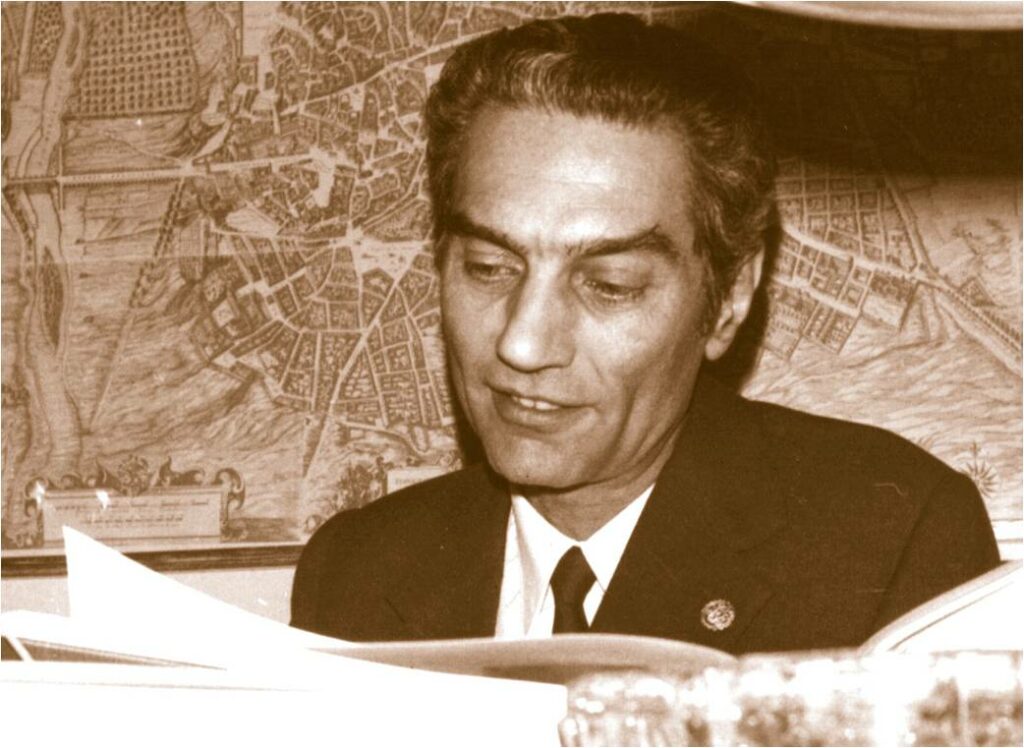
He was Vice Dean of the University Extension of the Faculty of Medicine in Seville from September 1976 to February 1977 and in the vote to elect the Dean, he came out unanimously although the students were absent from the vote ‘as a sign of mourning’ since it took place on the same day following the massacre of the labor lawyers on calle Atocha. He was in the Deanery until December 1978.
He was an absolutely vocational teacher, who prepared his classes with great rigor and dedication and who loved dealing with students and postgraduates. He also had a great way with words and his explanations were clear, precise and very educational. Proof of this is that his class, which usually occupied the time between 2 and 3 p.m., was always full and very often students from other courses came to listen to him just for the pleasure of hearing him. He was a great admirer of the Institución Libre de Enseñanza (Free Institution for Education) and of Giner de los Ríos, with his work being one of his favorite reads and his entire teaching methodology was based on this author and this Institution. In the same way, he always shied away from the ‘banking education’ that avoids communication and dialogue and is only based on rote efforts. He was one of the first professors to teach classes with clinical slides (he did not like text ones) and presenting real clinical histories of patients whose pathology and treatment he explained below.
For him, the University was always a place to which he dedicated all his efforts to achieve harmony between the classes and meet the needs that changed every year and were beginning to modernize. This caused him some displeasure, such as when he prevented the entry of the horse guards (popularly known as ‘los grises’. ‘The grey ones’ owing the color of their uniforms) into the Salamanca university campus during the Franco regime, literally standing in front of the horses at the doors of the building. His position, however, was not always well understood since for some he was too liberal, while others called him too conservative.
Proof of his commitment to the University was that he held various positions in the three Universities in which he held his Chair. Thus he was Vice Dean of the Faculty of Medicine of Salamanca from 1969 to 1972, Vice Chancellor of the University of Salamanca from June 1972 to December 1974, Vice Dean of the Faculty of Medicine in Seville from September 1976 to February 1977, Dean of the Faculty of Medicine in Seville from February 1977 to December 1978 and Vice Dean of the Faculty of Medicine of the Complutense University from 1983 to 1986.
In 1980 he moved to the Chair of Dermatology at the Complutense University in Madrid and although he was retired by decree in 1988 at the age of 65, he continued with teaching and healthcare work from that date until 1995 as Professor Emeritus.
In Madrid he was Head of Department at the San Carlos Clinical Hospital in Madrid and from 1984 to 1986, Director of the San Carlos Clinical Hospital in Madrid. During his years in Madrid his teaching and assistance work was very rich and he participated in numerous Congresses and meetings.
He was President of the Spanish Academy of Dermatology during the years 1982 to 1986. One of his marks was left clear in the restructuring of the journal Actas Dermato-sifiliográficas, whose writing, presentation and, above all, content he took exquisite care of.
He was a delegate of Spain in the European Union of Medical Specialists, section of Dermatology and Venereology (1983 – 1988), Vice President of the Ibero-Latin-American College of Dermatology (1976 to 1982), Founding Member of the Spanish Contact Dermatitis Research Group (GEIDC), subsidiary of the International Contact Dermatitis Research Group (ICDRG) since 1976, Honorary Member of the Société Française de Dermatologie since 1980, Honorary Member of the Sociedad Dermatológica Argentina since 1981, Honorary Member of the Dominican Society of Dermatology (1984), Member of the Bolivarian Association of Dermatology (1983), Member of the Colombian Society of the History of Medicine since 1984, Honorary Member of the Norwegian Society of Dermatology (1987), Honorary Member of the Hellenic Society of Dermatology (1987), Founding member of the European Academy of Dermatology and Venereology, Luxembourg 1987, and Member of the European Society of Contact Dermatitis (1988).
In 1989 he gave his entrance speech at the Royal National Academy of Medicine which was titled Ciencia y anécdota en el eczema de contacto (Science and anecdote in contact dermatitis). He occupied seat number 18. His collaboration with this institution was very close. He gave numerous speeches on current topics that were not restricted to Dermatology or medicine since he was also very interested in historical and lexicological aspects in relation to the previous ones.
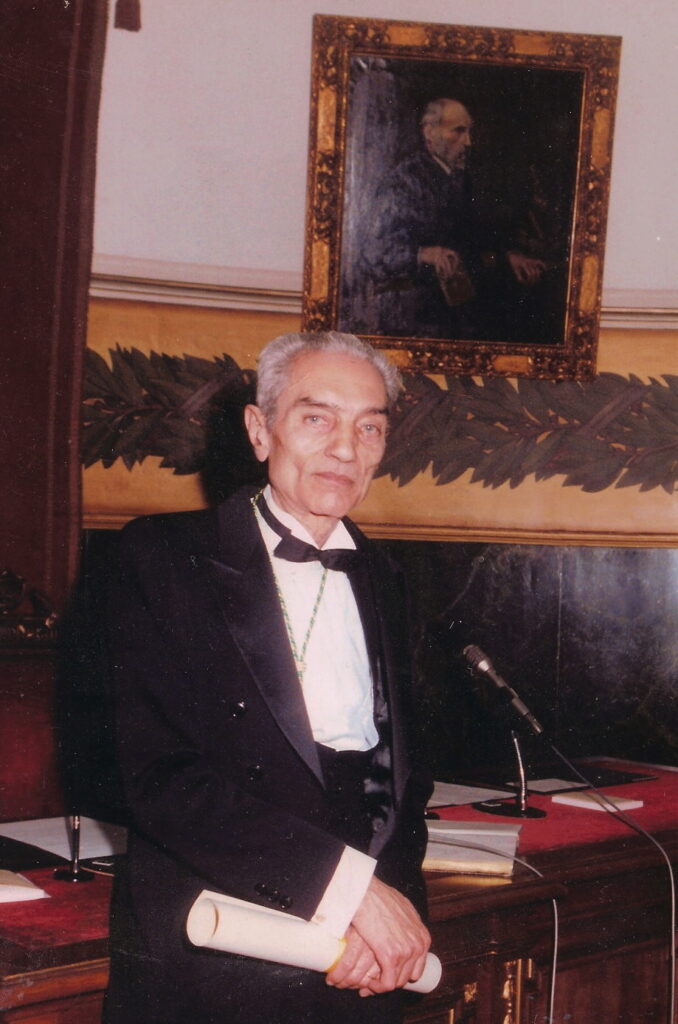
Convinced of the importance and need for the Royal National Academy of Medicine (RANM) to have a medical dictionary, he dedicated a great effort to the task of carrying it out, and coordinating its development. He was not able to see the finished work but there is no doubt that it was a magnificent task. (Dictionary of Medical Terms (RAMN), Panamericana Medical Ed. 2012). Another idea that the Royal National Academy of Medicine (RANM) wanted to carry out was the rehabilitation of all those who were expelled from the Institution due to the Civil War, but the latter was not possible.
A tireless reader since childhood, he dedicated many hours to history, essays, and philosophy, although he read all types of genres. He had great qualities as a writer that made his reading enjoyable and understandable. This was the result of the successive corrections he made of what he called the primitive ‘monster’. It was a pleasant but very laborious task for him. The care he gave to the writing of his texts is evidenced by the fact that Fernando Lázaro Carreter put his work Clinical Dermatology as an example of medical literature written with clarity and correctness.
He was a great teacher who, in addition to his university management and policy positions, carried out great work as a clinical doctor and humanist. His friendly and conversational spirit has undoubtedly left its mark on those who knew him and who continue to remember him many years after his death. This occurred on May 31st, 2002 in Madrid caused by lymphoma.
Written in 2020 by Begoña García Bravo, daughter of Professor Antonio García Pérez

